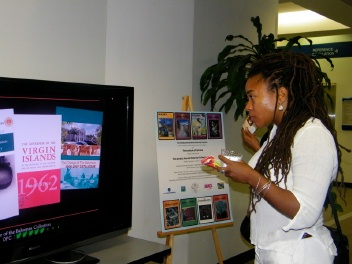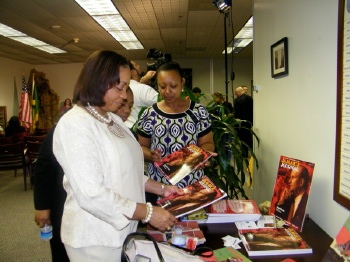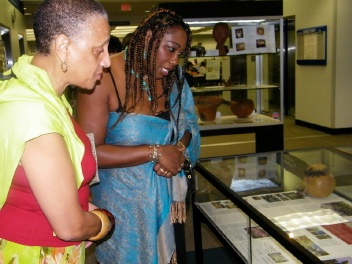Jamaica Journal now in Digitized version
MIAMI – In an effort to promote and showcase the history of Jamaica, the digitized version of the Jamaica Journal Historical Collection online was launched on Sunday (Nov. 15) at the Green Library of the Florida International University (FIU), Miami.
The Jamaica Journal described as the Caribbean’s leading cultural publication on Jamaica’s heritage is now celebrating its 40 year anniversary with 32 volumes. Published in 1967, the Journal boasts a wide range of topics including history, literature, science and environment, and the arts and can be considered a significant source of research material on Jamaica.
“Making the entire collection available online, will increase the awareness of the Journal’s historical and continued importance in documenting Jamaican heritage, culture and environment” according to Brooke Wooldridge of the Digital Library of the Caribbean (dLOC) of the University, one of the collaborating agencies.
Speaking with JIS News, she continued that making this collection available online in a digital library will introduce people to the publication. Students pursuing Caribbean studies will also have more access to even more information, she added.
Professor Barry Chevannes, Chairman of the Institute of Jamaica (IOJ) speaking at Reception to celebrate the historical launch said that the “digitization of the Jamaica Journal will mean a de-locking of the document from its imprisonment in time and space and releasing it to a readership and research community that has the potential to be as wide as cyberspace is wide.”
Describing the Journal as one of Jamaica’s most cherished products, Professor Chevannes said that the publication was a “window into the life of the Jamaican people.” It was founded in 1967 by former Prime Minister Edward Seaga who at the time was doing anthropological fieldwork among the rural and urban folk.
He continued that Mr. Seaga’s fascination with the beauty and cosmological sophistication of the Revival religion, led him to compose a poem titled “River Mumma” which he entered into the Festival competition under an assumed name, earning a gold medal.
As there was no outlet to publish the poem at the time, Mr. Seaga suggested that the Institute start a publication to showcase the works of writers and scholars on Jamaican and Caribbean culture. “River Mumma” was printed in the third volume in 1969. Since then, the issues continue to carry articles on the practices of the daily life of the Jamaican people, “providing snapshots of a people in a rapidly changing cultural life” according to Professor Chevannes.
Emphasizing its simplicity in language and style, Professor Chevannes said that the Journal was not a specialized organ but “one aimed at cultivating the sensibilities and intellect of as wide a readership as possible.”
He lauded the collaborative work of other partnering agencies including the Institute of Jamaica presuming that the digitization would help the sustained growth of the Journal. Other supporting agencies included the Jamaica Information Service, the Jamaica Tourist Board, Air Jamaica Limited and the Latin American and Caribbean Center.
Professor Chevannes spoke of the challenges of sustaining the Journal – the struggle to be relevant and cost-effective at the same time. He commended the expertise of the editor, Dr. Kim Robinson, a literary critic and writer. The more widely known the Journal is in cyberspace, the more interest it will create in ownership of copies while producing new subscribers he said.

Professor Andrea Queeley of Florida International University observing the digitized version of the Jamaica Journal at the launch at the Green Library on the campus location in Miami.
As he encouraged support from the Jamaican Diaspora, Professor Chevannes felt that the exhibited pages would evoke reminiscences of an ancestral homeland as nationals identified with the sights captured.
Already the Journal was being used by historians and scholars and the digitization would make the pages of this historical document limitlessly available for all, he stated.
He also said that the digitization process offered the 130 year old Institute of Jamaica, greater possibilities to fulfill its mission, encouraging the development of the arts, literature and science while providing a library for reading and research. Today, the IOJ Library has grown into the very largest in the English Caribbean with books dating back to the 17th century newspapers to the early 19th century and maps and other documents of rare quality.

Jamaica’s Consul General Sandra Grant Griffiths (forefront) observing copies of the Jamaica Journal at the launch of the digitized version of the publication at the Green Library of the Florida International University, South Campus. Looking on is Ms. Olive Senior of the Institute of Jamaica (IOJ).
Jamaica’s Consul General Sandra Grant Griffiths also echoed sentiments on the historical launch of the Jamaica Journal noting that the publication has helped shaped our nation and would continue to impact through the march of history preserving and increasing access to Jamaican material on the socio-cultural and political importance.
A mounted exhibition of collections of the Jamaica Journal accompanied the digitized launch. This was curated by Ms. Vicky Silvera, staff member of the FIU.
President of the Florida International University, Dr. Mark Rosenberg and Dean of the FIU Libraries, Dr. Laura Probst also gave welcoming remarks.

Cheryl Wynter and Dr. Donna Weir-Soley observing artifacts of Jamaican history at an exhibition which accompanied the recent launch of the digitized version of the 40 year old publication of the Jamaica Journal at the Green Library at the south Miami campus of the University.
Dr. Donna Weir-Soley, a Jamaican writer and FIU faculty member read articles from her new publication – “Eroticism, Spirituality and Resistance in Black Women’s Writings.”



